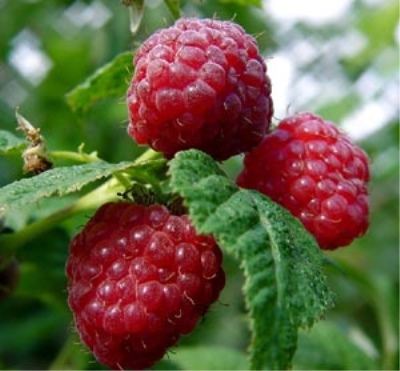
- Berry color: dark crimson
- Taste: sweet with sourness
- Ripening period: mid-late
- Berry weight, g: 3-4,2
- Yield: up to 5 kg per bush, 4.4 t / ha
- Frost resistance: winter hardy
- Tasting assessment: 4,7
- Appointment: universal
- Yield rate: high
- Appeared when crossing: Solge x Stolichnaya
The Peresvet raspberry variety was bred in our country. Raspberries ripen at a fairly late date. Peresvet is appreciated among gardeners for delicious, juicy fruits. Raspberries are unpretentious in care and endure even severe frosts.
Breeding history of the variety
Professor Ivan Vasilievich Kazakov took a personal part in the development of a new variety. The first experiments were carried out in Bryansk. Peresvet's parent varieties are Stolichnaya and Soldzh. Peresvet received official confirmation when it was entered into the State Register of Plants.
Description of the variety
Peresvet raspberry bushes are compact, located in an upright position. Shoots are brown colored, grow in medium quantity. The thorns are small, firm, with a pinkish base. The branches do not have a wax coating, they are red. Peresvet leaves are powerful, slightly wrinkled, twisted into a tube.
Ripening terms
Raspberry Peresvet belongs to a large-fruited variety, it begins to ripen at a fairly late date. This is around the end of July, beginning of August.
Growing regions
Currently, raspberries are most often grown in the Volga region and the Central Non-Black Earth Region. These are the most popular areas where Peresvet got its start and is still appreciated. Since raspberries are unpretentious to climatic conditions, they began to spread almost throughout the country.
Yield
Much depends on the region of cultivation. If this is the southern part of Russia, then the harvest will ripen in mid-June, if raspberries grow in cooler regions, in early August. In general, about 25 kg of raspberries can be collected from all over the garden - up to 5 kg per bush. The raspberry itself hangs on the branches for a long time.
Berries and their taste
The berries of the Peresvet variety have a sour taste, the approximate weight of one fruit is 3-4.2 grams, raspberries practically do not smell. The berries are elongated, the number of villi is minimal. When ripe, their color changes, becoming a matte cherry color. The drupes of the fruit are constantly closed, this allows the berries not to crumble.

Growing features
In order to increase the yield of Peresvet raspberries, special tactics are used. For example, the trellis method. Thus, the culture receives a lot of sunshine and fresh air, which is conducive to ventilation. The raspberry variety is quite high, so the structure is built at a height of 1.5 meters.
Site selection and soil preparation
For planting Peresvet raspberry bushes in the soil, the most illuminated areas are selected. Seedlings are planted mainly in May; the culture must be carefully monitored.
The soil must be prepared a month before planting. Pits are dug, their bottom is covered with a small layer of manure, then ash and potassium are added. If you decide to plant raspberries in a row, then you need to allocate a distance of 150 cm between the bushes.
The raspberry variety differs in that it can begin to spread throughout the entire area, letting out the roots. This is best prevented by burying special layers underground. You can plant sorrel on the border with Peresvet. Peresvet does not tolerate too oxidized soil, while sorrel oxidizes it, and raspberries stop growing in other places.


Pruning
If planting is postponed to September, be sure to cut off the stems. Peresvet should be 30-36 cm high. Old, dried leaves are usually removed. 8 strong branches are left on the bushes.

Watering and feeding
The plant does not tolerate high humidity, so it does not need to be watered as often. Particular attention should be paid to watering during fruit set and after harvest.
Peresvet is an unpretentious culture, ordinary mineral fertilizers are suitable for it. The culture can easily do without additional nutrients, but minimal feeding is required. This is important for the raspberries to produce good berries and grow normally. It is worth noting that in the first year of life, Peresvet does not require feeding. They begin to fertilize only three years later with a nitrogen solution. Fertilize with potassium before flowering and phosphorus at the end.


Frost resistance and preparation for winter
Raspberry Peresvet perfectly tolerates any cold. But it is worth noting that if there is no snow, additional protection is needed. If there is little snow, the bushes begin to bend to the ground, which can adversely affect its fertility. Covering materials can be film, sawdust.

Diseases and pests
Peresvet is susceptible to fungal diseases. Gray spots with a reddish border appear on the leaves. It is necessary to process the leaves with a special "Nitrafen" agent. It helps to get rid of the fungus almost immediately.
Peresvet is susceptible to harmful insects:
spider mite;
aphid;
gall midge;
weevil and stem fly.

Unfortunately, raspberries, like other plants, do not bypass various diseases and pests. Only armed with the knowledge and the necessary means for this, you can cope with such troubles. To help the plant, it is very important to be able to recognize the disease in time and begin timely treatment.
Reproduction
This variety produces a large number of shoots every year. It has an extensive root system, so it can be propagated in several ways:
dividing the parent bush;
root "children";
cuttings.

Review overview
Gardeners praise the Peresvet variety. It tastes great. The variety does not require excessive maintenance, it only needs minimal fertilization. Compotes and preserves are often made from raspberries, and when fresh they are transported over considerable distances without losing their taste.







































































